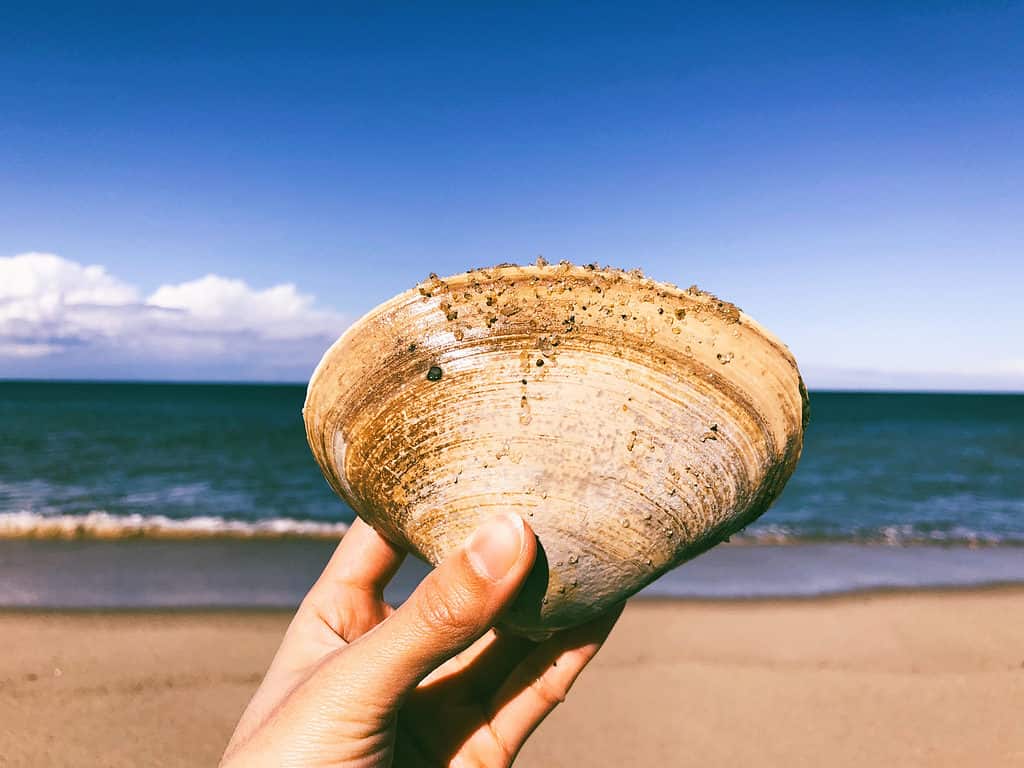On February 18, 2023, a man walking on a Florida beach alongside his family made a stunning discovery: an animal that is 214 years old! Blaine Parker discovered a huge ocean quahog (Arctica islandica), commonly known as a clam. Other names for the creature include “mahogany quahog” and “black clam.”
The Quahog
The ocean quahog is a filter-feeding bivalve mollusk that lives in sandy seabeds. It filters organic matter from the water using its siphon. The siphon is often the only visible part of the animal. The rest of it is usually buried beneath the sand on the ocean floor.
The quahog is the typical clam used in clam chowder, along with various other soups, stews, and seafood dishes. This clam is seen as a great choice for cooking since the United States quahog fishery is managed and sustainable. That fishery is located in two regions: Maine and Long Island, New York. The entire native range of the quahog extends from Newfoundland to North Carolina, well north of where Parker found a massive ocean quahog in Florida. How did this mollusk make it so far south? It probably has something to do with its age.

Quahogs are often collected for use in seafood dishes such as clam chowder.
©Lam Van Linh/Shutterstock.com
“Abra-Clam Lincoln”
A typical ocean quahog measures two to four inches in length. The quahog Parker found on Alligator Point in Franklin County, Florida, measured six inches across and weighed over two pounds.
The ocean quahog is a very slow-growing animal but also extremely long-lived. The age is determined by the number of layers on the shell. Quahogs generally add one layer per year. The quahog found by Parker had 214 layers on its shell, meaning the clam has been alive since 1809, the same year Abraham Lincoln was born! It didn’t take long for the clam to be given the nickname, “Abra-clam Lincoln.'”

The clam found in Florida in February 2023 was alive in 1809, the same year Abraham Lincoln was born!
©Everett Collection/Shutterstock.com
The Long Life of a Quahog
So how is a 214-year-old clam found in Florida when its typical habitat stretches from Canada to North Carolina? Clams are free floating in the egg and larvae stages and go wherever the current takes them. When mature, quahogs crawl along the ocean floor. At 214 years old, it’s likely that “Abra-clam Lincoln” slowly and methodically worked its way south over the last two centuries.
The quahog is among the world’s longest-lived organisms and is the oldest non-colonial animal on Earth. However, as amazing as Parker’s find is, it is not the oldest ocean quahog on record. That honor goes to a quahog nicknamed “Ming,” found off Iceland’s coast in 2006. Its shell feature 507 layers! The clam had been alive since 1499 when the Ming Dynasty ruled, hence the nickname.
A quahog’s shell is used to determine the animal’s age, but that’s not all. Like the rings of a tree, the layers on a quahog’s shell can help biologists understand what the marine environment was like in the past. They reveal information such as the salinity of the water and the ocean’s temperature over the animal’s lifespan.
At 214 years old, “Abra-clam Lincoln” has a lot to say. Marine researchers are definitely listening!

The oldest non-colonial animals on Earth are ocean quahogs. They regularly live up to 400 years old.
©Shanshan0312/Shutterstock.com
The photo featured at the top of this post is © Christopher Seufert/Shutterstock.com
Thank you for reading! Have some feedback for us? Contact the AZ Animals editorial team.






